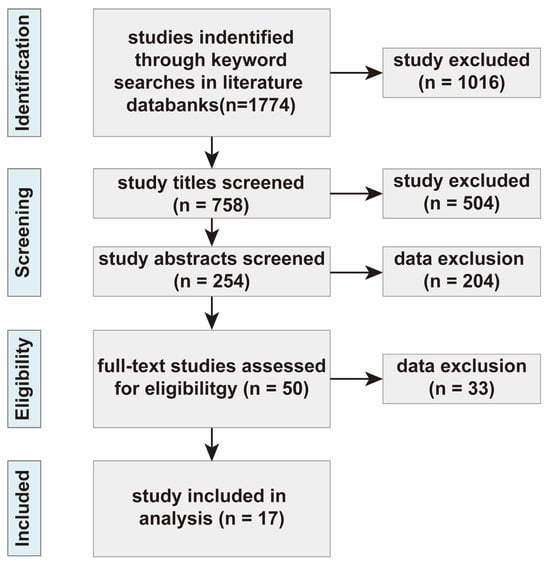-
 Heavy Metal Content in Tattoo and Permanent Makeup Inks and European Standards—Is There Still a Health Risk?
Heavy Metal Content in Tattoo and Permanent Makeup Inks and European Standards—Is There Still a Health Risk? -
 Multi- and Transgenerational Effects of Silver Ions (Ag+) in the ng/L Range on Life Cycle Parameters and Population Growth of the Midge Chironomus riparius (Diptera, Chironomidae)
Multi- and Transgenerational Effects of Silver Ions (Ag+) in the ng/L Range on Life Cycle Parameters and Population Growth of the Midge Chironomus riparius (Diptera, Chironomidae) -
 Heavy Metal Accumulation in Cattle from Western Pará: Human Health Risk Assessment
Heavy Metal Accumulation in Cattle from Western Pará: Human Health Risk Assessment -
 Characterization and Source Analysis of Water-Soluble Ions in PM2.5 at Hainan: Temporal Variation and Long-Range Transport
Characterization and Source Analysis of Water-Soluble Ions in PM2.5 at Hainan: Temporal Variation and Long-Range Transport -
 Unexpected High Blood Lead Levels in a Remote Indigenous Community in the Northeastern Peruvian Amazon
Unexpected High Blood Lead Levels in a Remote Indigenous Community in the Northeastern Peruvian Amazon
Journal Description
Toxics
Toxics
is an international, peer-reviewed, open access journal on all aspects of the toxic chemicals and materials, published monthly online by MDPI.
- Open Access— free for readers, with article processing charges (APC) paid by authors or their institutions.
- High Visibility: indexed within Scopus, SCIE (Web of Science), PubMed, PMC, Embase, CAPlus / SciFinder, AGRIS, and other databases.
- Journal Rank: JCR - Q1 (Toxicology) / CiteScore - Q1 (Chemical Health and Safety)
- Rapid Publication: manuscripts are peer-reviewed and a first decision is provided to authors approximately 18.1 days after submission; acceptance to publication is undertaken in 1.9 days (median values for papers published in this journal in the first half of 2025).
- Recognition of Reviewers: reviewers who provide timely, thorough peer-review reports receive vouchers entitling them to a discount on the APC of their next publication in any MDPI journal, in appreciation of the work done.
Impact Factor:
4.1 (2024);
5-Year Impact Factor:
4.6 (2024)
Latest Articles
Quantifying Influencing Factors of Dioxin Removal in Fly Ash Pyrolysis Through Meta-Analysis and Structural Equation Modeling
Toxics 2025, 13(12), 1072; https://doi.org/10.3390/toxics13121072 - 12 Dec 2025
Abstract
The treatment of polychlorinated dibenzodioxins and polychlorinated dibenzofurans (PCDD/Fs) in incineration fly ash presents a significant challenge in solid hazardous waste management. This study systematically analyzed the influence mechanisms of multiple factors on the removal efficiency of PCDD/Fs during fly ash pyrolysis. It
[...] Read more.
The treatment of polychlorinated dibenzodioxins and polychlorinated dibenzofurans (PCDD/Fs) in incineration fly ash presents a significant challenge in solid hazardous waste management. This study systematically analyzed the influence mechanisms of multiple factors on the removal efficiency of PCDD/Fs during fly ash pyrolysis. It integrated 4068 datasets conducted between 2010 and 2025 through meta-analysis. Results show that Al2O3, CaO, SiO2, and Cl in fly ash components enhance the removal efficiency by 14.0%, while Fe2O3 (Content greater than 5.7%) exhibits inhibitory effects. Cd and Cr demonstrate a bimodal response pattern: low/high concentrations promote removal, while medium concentrations inhibit it. Process optimization identified the optimal parameter combination as pyrolysis temperatures of 500–900 °C, residence time of 50–90 min, and a gas flow rate greater than or equal to 400 mL/min. A significant negative correlation was observed between the initial dioxin concentration and removal efficiency. This study established a structural equation modeling (SEM) model to describe how metallic and nonmetallic components, fly ash components, and pyrolysis conditions determine removal efficiency. Fly ash composition was confirmed as the most influential factor (total effect = 0.3194), with fixed carbon and ash content being the most reliable indicators. Among pyrolysis conditions, gas conditions (flow rate, gas type) also significantly affected removal efficiency (total effect = 0.2357). Conversely, nonmetallic components and excessively prolonged pyrolysis time (beyond the window) consistently reduced removal efficiency. These findings provide theoretical support for upgrading fly ash pyrolysis processes toward low-carbon and resource-efficient operations.
Full article
(This article belongs to the Special Issue Emissions, Environmental Behavior, Pollution Distribution, Modeling, and Risk Assessment of Persistent Organic Pollutants (POPs))
►
Show Figures
Open AccessReview
Prenatal Exposure to Tobacco Smoke and Vaping Aerosols: Mechanisms Disrupting White-Matter Formation
by
Sebastián Beltran-Castillo, Juan Pablo Espinoza and Michelle Grambs
Toxics 2025, 13(12), 1071; https://doi.org/10.3390/toxics13121071 - 12 Dec 2025
Abstract
White-matter development during fetal life represents one of the most vulnerable processes to environmental disruption, as it relies on the precisely timed proliferation, migration, and differentiation of oligodendrocyte lineage cells. Among environmental threats, exposure to toxic compounds contained in tobacco smoke and vaping
[...] Read more.
White-matter development during fetal life represents one of the most vulnerable processes to environmental disruption, as it relies on the precisely timed proliferation, migration, and differentiation of oligodendrocyte lineage cells. Among environmental threats, exposure to toxic compounds contained in tobacco smoke and vaping aerosols represents a major yet preventable risk during pregnancy. Despite growing awareness, tobacco smoking remains widespread, and a substantial proportion of the population—including pregnant women—continues to perceive electronic nicotine delivery systems (ENDS) as less harmful, a misconception that contributes to persistent prenatal exposure. These products expose the fetus to numerous substances that readily cross the placenta and reach the developing brain, including compounds with endocrine-disrupting activity, where they interfere with white-matter development. Epidemiological and neuroimaging studies consistently reveal microstructural alterations in white matter that correlate with long-term cognitive and behavioral impairments in offspring exposed in utero. These alterations may arise from both nicotine-specific pathways and the actions of other toxicants in cigarette smoke and ENDS aerosols that cross the placenta and disrupt white-matter emergence and maturation. Preclinical research provides mechanistic insight: nicotine acts directly on nicotinic acetylcholine receptors (nAChRs) in oligodendrocyte precursor cells, disrupting calcium signaling and differentiation, while additional constituents of smoke and vaping aerosols also affect astrocyte and microglial function and disturb the extracellular milieu required for proper myelination.
Full article
(This article belongs to the Special Issue Reproductive and Developmental Toxicity of Environmental Factors)
►▼
Show Figures
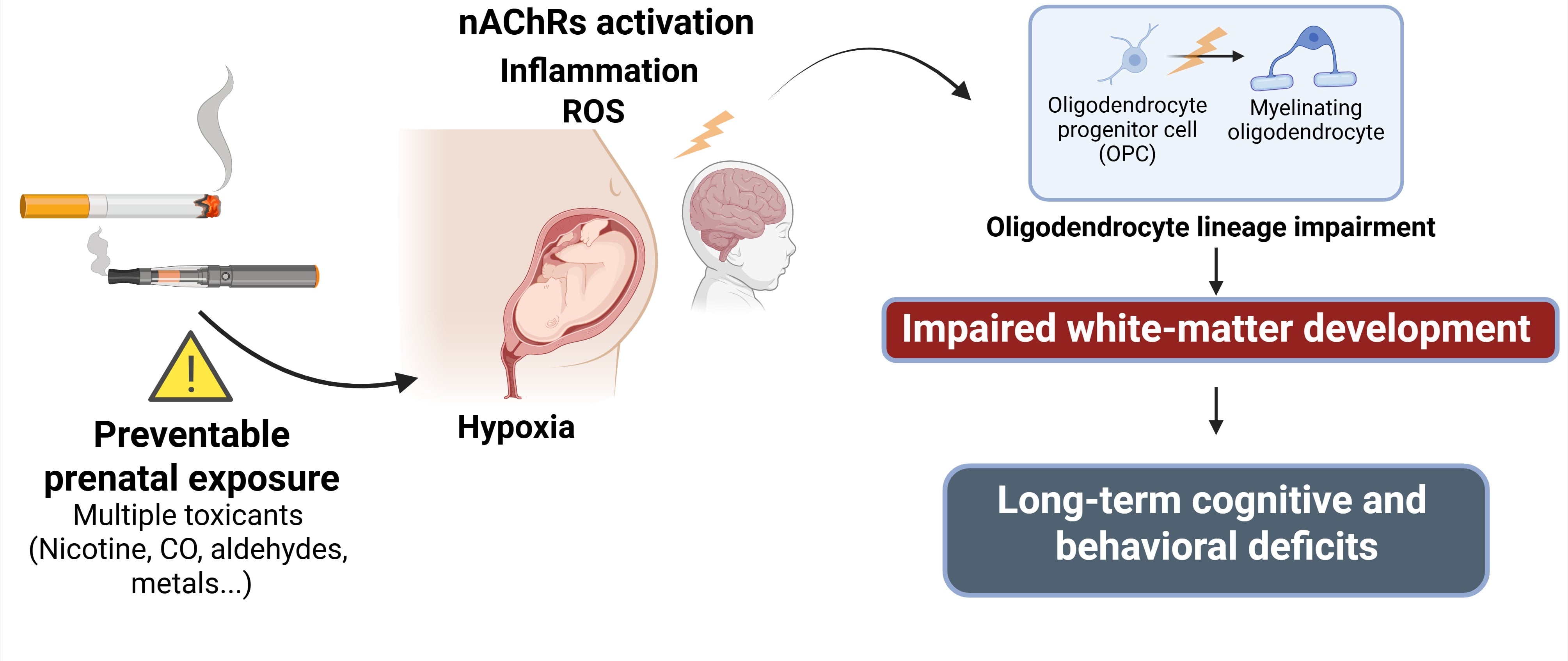
Graphical abstract
Open AccessArticle
Microplastic Distribution and Transport Mechanisms in the South Sea and East China Sea of Korea
by
Byeongkyu Min, Huiho Jeong, Chon-Rae Cho and Hyeon-Seo Cho
Toxics 2025, 13(12), 1070; https://doi.org/10.3390/toxics13121070 - 12 Dec 2025
Abstract
Microplastic distribution off the coast of Korea was investigated by collecting and analyzing surface seawater and sediment samples from the South Sea and East China Sea during the summer. Microplastic abundance was found to be highest in the YE area, followed by the
[...] Read more.
Microplastic distribution off the coast of Korea was investigated by collecting and analyzing surface seawater and sediment samples from the South Sea and East China Sea during the summer. Microplastic abundance was found to be highest in the YE area, followed by the EC area and the SS area in both seawater and sediment matrices. The dominant microplastic shapes and sizes were fragments and small particles (0.02–0.3 mm), respectively. This distribution pattern is explained by the transport of low-density, small-sized microplastics from other seas via the high salinity Taiwan Warm Current and Tsushima Warm Current flowing northward from the southern waters of the study area. In contrast, microplastics originating from the Korean landmass along the southern coast were less abundant, likely due to their dispersal by the strong currents of the Jeju Warm Current, Taiwan Warm Current, and Tsushima Warm Current, which carry microplastics toward the Korean Strait. This study highlights the critical role of prevailing ocean currents in shaping the spatial distribution of microplastics, providing insight into sources and transport mechanisms relevant for regional marine pollution management in the Korean coastal waters.
Full article
(This article belongs to the Special Issue Microplastics in Atmospheric, Aquatic, and Soil Ecosystems: Occurrence, Impacts, and Innovations in Detection and Mitigation)
►▼
Show Figures
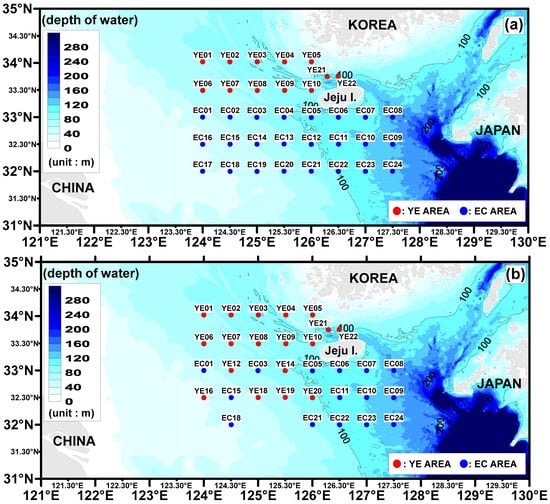
Figure 1
Open AccessReview
Advances in Microbial Remediation of Heavy Metal-Contaminated Soils: Mechanisms, Synergistic Technologies, Field Applications and Future Perspectives
by
Hongxia Li, Xinglan Cui, Yingchun Sun, Peng Zheng, Lei Wang and Xinyue Shi
Toxics 2025, 13(12), 1069; https://doi.org/10.3390/toxics13121069 - 12 Dec 2025
Abstract
Heavy-metal contamination poses a significant global threat to soil environments, underscoring the necessity for effective and sustainable remediation technologies. This review methodically summarizes advances in the field of microbial remediation of heavy metal-contaminated soils, organized around four major dimensions: remediation mechanisms, synergistic technologies,
[...] Read more.
Heavy-metal contamination poses a significant global threat to soil environments, underscoring the necessity for effective and sustainable remediation technologies. This review methodically summarizes advances in the field of microbial remediation of heavy metal-contaminated soils, organized around four major dimensions: remediation mechanisms, synergistic technologies, field applications, and future prospects. Firstly, the remediation mechanisms are elucidated, encompassing molecular interactions, cellular adaptation, and community-level cooperative responses. Secondly, the integration of microbes with functional materials and bioelectrochemical systems (BESs) is evaluated, with these materials providing support, electron mediation, and micro-environment regulation that markedly improve remediation efficiency and stability. Moreover, illustrative field cases demonstrate pivotal technological pathways and cost-effectiveness when transitioning from laboratory- to field-scale applications. Finally, emerging frontiers such as synthetic biology-engineered microbes, AI-driven microbial design, circular-economy value recovery, and policy-governance innovations are discussed, proposing essential elements for building a “predictable-controllable-sustainable” microbial remediation platform. This review aims to provide a comprehensive knowledge framework for researchers and to offer decision-making guidance for practitioners and policymakers, thereby advancing microbial remediation toward higher efficiency, reliability, and scalability.
Full article
(This article belongs to the Special Issue Environmental Study of Waste Management: Life Cycle Assessment)
►▼
Show Figures

Graphical abstract
Open AccessArticle
Assessment of Chromium Contamination in Aquatic Environments near Tannery Industries: A Portuguese Case Study
by
Liliana J. G. Silva, Maria J. G. Casimiro, Angelina Pena, Maria J. Campos and André M. P. T. Pereira
Toxics 2025, 13(12), 1068; https://doi.org/10.3390/toxics13121068 - 11 Dec 2025
Abstract
Environmental contamination from industrial activities remains a significant concern, with tanneries being major contributors of chromium (Cr) to aquatic systems. Cr, a heavy metal with multiple oxidation states, varies in toxicity and poses risks to both ecosystems and human health. In Portugal, the
[...] Read more.
Environmental contamination from industrial activities remains a significant concern, with tanneries being major contributors of chromium (Cr) to aquatic systems. Cr, a heavy metal with multiple oxidation states, varies in toxicity and poses risks to both ecosystems and human health. In Portugal, the Alcanena region is particularly affected, hosting around 60 tanning industries. This study assessed total Cr levels in water from the Alviela River and Carvalho Stream, with particular focus on the impact of a local wastewater treatment plant (WWTP) that processes tannery effluents. Water samples were collected upstream and downstream of the WWTP discharge point. Analytical techniques included graphite furnace atomic absorption spectrometry and inductively coupled plasma optical emission spectroscopy, with a detection limit of 0.33 µg L−1. The highest Cr concentration (560 µg L−1) was found in the Carvalho Stream, downstream of the WWTP, confirming its contribution to local contamination. In the Alviela River, Cr concentrations ranged from 8 to 50 µg L−1 downstream of the WWTP, exceeding the predicted no-effect concentration for aquatic organisms and the safety limit for human consumption (25 µg L−1). These findings highlight, for the first time, the ongoing environmental impact of tannery effluents in this region and emphasize the urgent need for improved monitoring and pollution control measures.
Full article
(This article belongs to the Special Issue Heavy Metals and Emerging Contaminants in Aquatic and Soil Environments: Migration, Transformation, Ecological Risks, and Remediation)
►▼
Show Figures
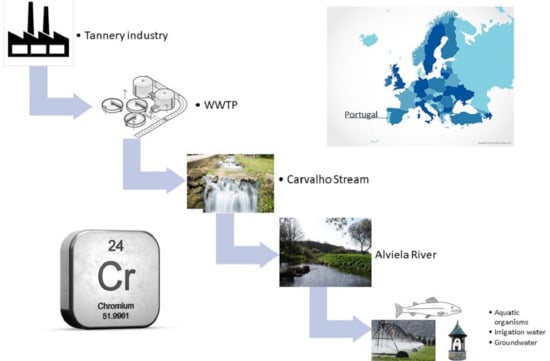
Graphical abstract
Open AccessArticle
Impact of Air Pollution Control Devices on VOC Profiles and Emissions from Municipal Waste Incineration Plant
by
Jun Liu, Duanhe Zhao, Fei Wu, Huanhuan Luo, Daxiang Hou and Yue Peng
Toxics 2025, 13(12), 1067; https://doi.org/10.3390/toxics13121067 - 11 Dec 2025
Abstract
With the rapid development of urbanization, municipal waste incineration (MWI) has become the primary method of waste disposal in urban areas, leading to growing concerns about volatile organic compounds (VOC) emissions. This study conducted full-process VOC field sampling at a representative MWI plant
[...] Read more.
With the rapid development of urbanization, municipal waste incineration (MWI) has become the primary method of waste disposal in urban areas, leading to growing concerns about volatile organic compounds (VOC) emissions. This study conducted full-process VOC field sampling at a representative MWI plant in China to investigate the emission characteristics and removal efficiencies of air pollution control devices (APCDs). A total of 59 VOC species were identified in the flue gas, including 5 alkanes/alkenes, 14 aromatics, 8 oxygenated-VOCs, and 32 halogenated hydrocarbons. The activated carbon injection combined with fabric filters and wet desulfurization tower demonstrated varying removal efficiencies across VOC groups, with synergistic removal efficiencies being ranked as follows: alkanes/alkenes (90.9%) > aromatics (87.0%) > halogenated hydrocarbons (61.3%) > O-VOCs (42.2%). The total VOC removal efficiency reached 77.5%. The VOCs emission factor of the MWI plant was calculated as (1.9 ± 0.6) × 103 ng/g-waste, which would rise to (8.4 ± 2.1) × 103 ng/g-waste in the absence of APCDs. This indicates that the current APCD system reduces VOC emissions by approximately 6.52 × 104 g annually from this MWI plant, highlighting the crucial role of multistage APCDs in mitigating VOC pollution.
Full article
(This article belongs to the Section Air Pollution and Health)
►▼
Show Figures

Graphical abstract
Open AccessArticle
Metabolomic Impact of Maternal Barium Exposure on Miscarriage Risk: Identification of Metabolic Biomarkers and Construction of a Risk Prediction Model
by
Xiaoyu Zhao, Ziwei Guo, Shuangshuang Zhao, Danyang Wan, Jie Xu, Yifan Xu, Yujie Liu, Haoyi Xu, Ziyang Wang and Qing Xu
Toxics 2025, 13(12), 1066; https://doi.org/10.3390/toxics13121066 - 10 Dec 2025
Abstract
This study investigated the relationship between maternal barium (Ba) exposure and the risk of miscarriage using metabolomics and machine learning. Analyses were performed on samples from 183 pregnant women from Nanjing: the concentration of Ba in whole blood was measured using inductively coupled
[...] Read more.
This study investigated the relationship between maternal barium (Ba) exposure and the risk of miscarriage using metabolomics and machine learning. Analyses were performed on samples from 183 pregnant women from Nanjing: the concentration of Ba in whole blood was measured using inductively coupled plasma mass spectrometry (ICP-MS), and untargeted metabolomics was performed on decidual tissue using high-resolution accurate mass spectrometry (UHPLC-QExactive HF-X). A metabolome-wide association study (MWAS) and mediation interaction effect analysis (MITM) identified metabolites and pathways linked to Ba exposure and miscarriage risk. Among 523 detected metabolites, 19 metabolites and 5 pathways were significantly associated with both Ba exposure and miscarriage, particularly glycerophospholipid metabolism. The effect of Ba exposure on miscarriage risk was mediated by five metabolites, with cuminaldehyde showing the highest share of the total mediating effect (54.74%). These metabolites, including N-acetyl-L-methionine, 4-hydroxynonenal, DG(18:0/18:3(9Z,12Z,15Z)/0:0), 10-formyldihydrofolate, and eicosadienoic acid, were used as biomarkers in a predictive model. The XGBoost model achieved an optimal AUC of 0.90 (95%CI: 0.83–0.96). This study suggests that maternal Ba exposure increases miscarriage risk, potentially through disruptions in amino acid metabolism, oxidative stress, and lipid peroxidation, and highlights the potential of metabolite biomarkers for predicting adverse birth outcomes.
Full article
(This article belongs to the Special Issue State-of-the-Art Environmental Chemical Exposomics and Metabolomics—2nd Edition)
►▼
Show Figures
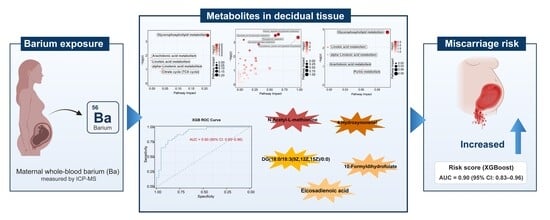
Graphical abstract
Open AccessFeature PaperArticle
Co-Culture of Primary Human Bronchial Epithelial Cells at the Air–Liquid Interface and THP-1 Macrophages to Investigate the Toxicity of Polycyclic Aromatic Hydrocarbons
by
Kyle S. Burns, Audrey G. Biggerstaff, Jamie M. Pennington and Susan C. Tilton
Toxics 2025, 13(12), 1065; https://doi.org/10.3390/toxics13121065 - 9 Dec 2025
Abstract
The development of new approach methodologies that include human cells differentiated into organotypic formats is of high interest due to their structural and functional similarities to tissues in vivo, enabling mechanistic understanding and translation to adverse health outcomes in humans. However, these systems
[...] Read more.
The development of new approach methodologies that include human cells differentiated into organotypic formats is of high interest due to their structural and functional similarities to tissues in vivo, enabling mechanistic understanding and translation to adverse health outcomes in humans. However, these systems often fail to capture complex intercellular signaling required for processes such as pulmonary inflammation induced by polycyclic aromatic hydrocarbons (PAHs). To investigate airway epithelial–macrophage interactions in response to benzo[a]pyrene and a PAH mixture (Tox Mix), co-culture models utilizing primary human bronchial epithelial cells (HBECs) differentiated at the air–liquid interface were cultured with THP-1 macrophages either directly or indirectly, alongside HBECs alone. After 24 h of exposure, cytokine expression (IL1B, IL6, CXCL8, TNF) as well as PAH biomarkers previously identified for chemical metabolism (CYP1A1, CYP1B1), oxidative stress (ALDH3A1, HMOX1, NQO1), and barrier integrity (TJP2) were evaluated. Cytotoxicity and barrier integrity were also assessed. HBECs alone and direct co-cultures exhibited similar responses after PAH treatment, while indirect co-cultures showed lower sensitivity to induction of inflammatory cytokines and CYP1A1 and CYP1B1 biomarker expression following exposure to PAHs. The expression of other biomarkers, including ALDH3A1, HMOX1, and NQO1, remained largely consistent across all models after treatment. Overall, these findings suggest that direct co-culture systems may provide a more physiologically relevant platform for studies of PAH-induced toxicity and demonstrate that the configuration of co-culture systems can influence cellular responses to chemical exposure.
Full article
(This article belongs to the Special Issue Emerging Pollutants in the Air and Health Risks)
►▼
Show Figures

Graphical abstract
Open AccessArticle
Sentinel Equines in Anthropogenic Landscapes: Bioaccumulation of Heavy Metals and Hematological Biomarkers as Indicators of Environmental Contamination
by
Maria Popescu, Mirela Alexandra Tripon, Alexandru Florin Lupșan, Denisa Bungărdean, Cristian Mihăiță Crecan, Mihai Musteata, Paula Maria Pașca, Sorin Marian Mârza, Rober Cristian Purdoiu, Ionel Papuc, Radu Lăcătuș, Caroline Maria Lăcătuș, Luciana Cătălina Panait, Teodora Sonia Patrichi, Ileana-Rodica Matei, Cristian-Radu Sisea, Claudiu Ioan Bunea, Anamaria Călugăr, Ioan Valentin Petrescu-Mag, Zsofia Daradics and Florin-Dumitru Boraadd
Show full author list
remove
Hide full author list
Toxics 2025, 13(12), 1064; https://doi.org/10.3390/toxics13121064 - 9 Dec 2025
Abstract
Environmental contamination with heavy metals, resulting from industrialization, urbanization, and agricultural intensification, poses serious ecological and health risks. Horses, due to their grazing behavior and close association with human environments, serve as reliable sentinel species for assessing environmental pollution. This study aimed to
[...] Read more.
Environmental contamination with heavy metals, resulting from industrialization, urbanization, and agricultural intensification, poses serious ecological and health risks. Horses, due to their grazing behavior and close association with human environments, serve as reliable sentinel species for assessing environmental pollution. This study aimed to evaluate the bioaccumulation of heavy metals and trace elements in different biological matrices of horses—blood, hair, hooves, and synovial fluid—and to investigate their relationship with hematological biomarkers as indicators of physiological stress. Samples were collected from horses raised in anthropogenically influenced areas and analyzed using inductively coupled plasma mass spectrometry (ICP–MS). Hematological parameters were determined with an automated analyzer to assess systemic effects. The results revealed significant variations in metal concentrations among matrices, with keratinized tissues reflecting long-term exposure, while blood and synovial fluid indicated recent contamination. Correlations between elevated metal levels and altered hematological values suggested oxidative stress and adaptive physiological responses. These findings demonstrate the value of multi-matrix biomonitoring in evaluating both environmental quality and animal health. Horses effectively reflect the cumulative impact of heavy metal exposure, supporting their role as bioindicators within a One Health framework that links environmental, animal, and human well-being.
Full article
(This article belongs to the Section Exposome Analysis and Risk Assessment)
►▼
Show Figures

Figure 1
Open AccessFeature PaperArticle
Omega-3 Fatty Acid Intake and Oxylipin Production in Response to Short-Term Ambient Air Pollution Exposure in Healthy Adults
by
Hao Chen, Siqi Zhang, Xiannen Pan, Alexandra Schneider, David Diaz-Sanchez, James Samet and Haiyan Tong
Toxics 2025, 13(12), 1063; https://doi.org/10.3390/toxics13121063 - 9 Dec 2025
Abstract
Oxylipins are specialized lipid mediators that can have dual functions, either promoting inflammation or supporting resolution. Exposure to air pollution is associated with systemic inflammation that may be modified by oxylipins derived from polyunsaturated fatty acids (FA). In this study, we examined whether
[...] Read more.
Oxylipins are specialized lipid mediators that can have dual functions, either promoting inflammation or supporting resolution. Exposure to air pollution is associated with systemic inflammation that may be modified by oxylipins derived from polyunsaturated fatty acids (FA). In this study, we examined whether short-term air pollution exposure is associated with changes in circulating oxylipins in healthy adults, who were on high- or low-dietary omega-3 fatty acid (n-3 FA) intakes. We measured 56 oxylipin species from participants’ plasma samples and employed mixed-effects models to assess the associations, stratified by n-3 FA groups. Plasma concentrations of oxylipins derived from n-3 FA [e.g., 14-hydroxydocosahexaenoic acid (14-HDHA) & 11-hydroxydocosahexaenoic acid (11-HDoHE), and 12-hydroxyeicosapentaenoic acid (12-HEPE)] were significantly higher in the high n-3 FA group compared to the low group. Conversely, selected oxylipins derived from n-6 FA [e.g., 15-hydroxyeicosatetraenoic acid (15-HETE) and 14,15-Dihydroxyeicosatrienoic acid (14,15-DiHETrE)] were significantly lower in the high n-3 group. Exposure to PM2.5, O3, and NO2 was associated with reductions in pro-inflammatory oxylipins produced by lipoxygenase in the high n-3 FA group, but not in the low group; for example, 12-HETE. Furthermore, participants in the high n-3 group exposed to PM2.5, O3, and NO2 had elevated levels of n-3 FA-derived pro-resolving oxylipins compared to those in the low n-3 group; for instance, 12-HEPE and 14-HDHA & 11-HDoHE. In conclusion, short-term air pollution exposure was associated with lower pro-inflammatory and higher pro-resolving oxylipin levels in the high n-3 FA group. These findings suggest n-3-derived lipid metabolites may promote inflammation resolution induced by air pollution.
Full article
(This article belongs to the Section Air Pollution and Health)
►▼
Show Figures

Graphical abstract
Open AccessArticle
Valorization of Silicon-Rich Solid Waste into Highly Active Silicate Adsorbents for Heavy Metal Removal
by
Shaojun Jiang, Xurong Huang, Huayi Chen, Jiahe Miao, Xinsheng Xiao, Yueying Zhuo, Xiang Li and Yong Chen
Toxics 2025, 13(12), 1062; https://doi.org/10.3390/toxics13121062 - 9 Dec 2025
Abstract
Waste stone powder is a major solid waste byproduct of stone operations. This study developed a novel “alkali activation-calcination” process that efficiently converts waste stone powder into high-value-added silicon-based materials (SSM). This study elucidated the morphological evolution of silicon during the conversion process
[...] Read more.
Waste stone powder is a major solid waste byproduct of stone operations. This study developed a novel “alkali activation-calcination” process that efficiently converts waste stone powder into high-value-added silicon-based materials (SSM). This study elucidated the morphological evolution of silicon during the conversion process and revealed the formation mechanism of active silicon. Through further integration of batch adsorption experiments and multi-technique characterization analysis, the immobilization efficacy of this material for heavy metals cadmium/lead was elucidated, revealing both direct and indirect interfacial reaction mechanisms. The results demonstrate that in-creasing the calcination temperature, alkali activator concentration, and calcination duration enhances the reactive silica content in SSM. NaOH as activator, the calcination process significantly reduces both the thermal decomposition temperature of raw materials and the initial temperature required for silicon conversion. Under optimized conditions (WG:MD:activator = 1:0.8:0.32, temperature = 800 °C, time = 1 h), the reactive silica content reached 24.30%. The generation rate of reactive silica is governed by the combined effects of interfacial chemical reactions and solid-phase product layer diffusion. Under idealized laboratory conditions, the maximum adsorption capacities (Qm) of SSM were determined to be 57.40 mg/g for cadmium and 496 mg/g for lead, which are significantly higher than those of many other adsorbents. Continuous desorption experiments and characterization analyses confirm that Cd and Pb adsorption by SSM is primarily driven by electro-static interactions, complexation, precipitation, and coordination, while ion ex-change plays a secondary role. Highly reactive silica facilitates interactions between Cd/Pb and oxygen-containing functional groups (e.g., -OH, ≡Si-OH, Si-O-Si), promoting precipitate formation for effective heavy metal removal. This work offers theoretical guidance for valorizing silica-rich waste rock powder. It is important to note, however, that while the adsorption capacity of SSM is encouraging, its practical implementation requires resolving key issues identified during the lab-to-application transition.
Full article
(This article belongs to the Section Toxicity Reduction and Environmental Remediation)
►▼
Show Figures

Graphical abstract
Open AccessArticle
Pulmonary Function and Influencing Factor Investigation for Rural Homemakers in the Fenwei Plain, China
by
Rong Feng, Kaiyuan Wang, Hongmei Xu, Yunxuan Gu, Liu Yang, Jian Sun and Zhenxing Shen
Toxics 2025, 13(12), 1061; https://doi.org/10.3390/toxics13121061 - 7 Dec 2025
Abstract
To understand the pulmonary function and main influencing factors of homemakers in rural Xi’an, a representative city in Northwest China, 72 housewives (61 ± 9 years old) were randomly selected from the rural area of Lantian, Xi’an. The questionnaire survey and pulmonary function
[...] Read more.
To understand the pulmonary function and main influencing factors of homemakers in rural Xi’an, a representative city in Northwest China, 72 housewives (61 ± 9 years old) were randomly selected from the rural area of Lantian, Xi’an. The questionnaire survey and pulmonary function test were performed on the subjects in winter and summer, respectively. The general linear model and variance analysis were used to analyze the influencing factors of pulmonary function. Key lung function indices included Vital Capacity (VC: 2.06 ± 0.48 L), Forced Expiratory Volume in First Second (FEV1: 1.91 ± 0.52 L), Forced Vital Capacity (FVC: 2.23 ± 0.59 L), and the FEV1/FVC ratio (0.86 ± 0.07). Several factors were found to cause impairment of pulmonary function. Age has the greatest effect on various indicators of lung function (Eta: 22.3%); the effect of indoor ventilation, season, and second-hand smoke (SHS) exposure on pulmonary function was comparable (3.2–5.9%). There were significant differences on most pulmonary function indices between four age groups (p = 0.000–0.005), and the age of <57 years old displayed the highest lung function index values. The lung function of the ventilation group was better than that of the non-ventilation group. And the lung function of the non-SHS exposure group was better than that of the SHS exposure group. No clear seasonal pattern of pulmonary function was found in this study. Aging, SHS exposure, and poor ventilation showed negative effects on most pulmonary function indices. It is recommended to actively publicize the harm of smoking and strengthen house ventilation to improve lung function in local homemakers.
Full article
(This article belongs to the Section Air Pollution and Health)
►▼
Show Figures

Graphical abstract
Open AccessFeature PaperArticle
Toxic Effects of Neonicotinoid Insecticide Imidacloprid and Polystyrene Microplastics on Rat Neuroblastoma B104 Cells
by
Tao Wang, Gulijiazi Yeerkenbieke, Yun Yang, Shuai Shi and Xiaoxia Lu
Toxics 2025, 13(12), 1060; https://doi.org/10.3390/toxics13121060 - 7 Dec 2025
Abstract
Imidacloprid (IMI) and polystyrene microplastics (PS-MPs) are common environmental pollutants, posing potential risks to ecosystems and human health. However, there is limited research on their toxic effects on nerve cells, particularly under combined exposure conditions. This study aimed to evaluate the toxic effects
[...] Read more.
Imidacloprid (IMI) and polystyrene microplastics (PS-MPs) are common environmental pollutants, posing potential risks to ecosystems and human health. However, there is limited research on their toxic effects on nerve cells, particularly under combined exposure conditions. This study aimed to evaluate the toxic effects of IMI and PS-MPs alone and in combination on rat neuroblastoma B104 cells. Based on a cell viability assay (48 h), the No Observed Adverse Effect Levels of IMI and PS-MPs were 260 mg/L and <150 mg/L, respectively. To study their effects on the cholinergic system and oxidative stress, similar concentrations of IMI (2.6, 26, 260 mg/L) and PS-MPs (3, 30, 300 mg/L), alone and in combination, were exposed to B104 cells for 48 h. The results showed that IMI alone decreased acetylcholine (ACh) and acetylcholinesterase (AChE) contents, PS-MPs alone increased ACh and AChE contents, and under the combined condition, the effect of PS-MPs predominated over IMI. Both IMI and PS-MPs alone decreased the ratio of reduced glutathione (GSH) to oxidized glutathione (GSSG), indicating oxidative stress, and under the combined condition, the ratio of GSH/GSSG decreased more, but were less than the sum of the decreases that were observed under treatment by both compounds alone. The combined exposure exhibited antagonistic effects on all endpoints. Results of this study provides a scientific basis for the environmental risk assessment of microplastics and neonicotinoid pesticides.
Full article
(This article belongs to the Special Issue Environmental Transport, Transformation and Effect of Pollutants)
►▼
Show Figures

Graphical abstract
Open AccessArticle
Electromagnetic Fenton Combined with Electro-Biological Coupling Technology for Treating High-Nitrogen Organic Chemical Wastewater
by
Dengyan Mu, Xiaojie Chen, Peiyu Zhao, Houhui Zhang, Zhujun Bai and Baoshan Wang
Toxics 2025, 13(12), 1059; https://doi.org/10.3390/toxics13121059 - 6 Dec 2025
Abstract
High-nitrogen organic chemical wastewater is characterized by high chemical oxygen demand (CODCr), poor biodegradability, and toxic nitrogenous organics, posing significant challenges for conventional biological treatment. In this study, a dual-electrical treatment strategy integrating an electromagnetic Fenton (EM-Fenton) pretreatment unit with a
[...] Read more.
High-nitrogen organic chemical wastewater is characterized by high chemical oxygen demand (CODCr), poor biodegradability, and toxic nitrogenous organics, posing significant challenges for conventional biological treatment. In this study, a dual-electrical treatment strategy integrating an electromagnetic Fenton (EM-Fenton) pretreatment unit with a three-dimensional biofilm electrode reactor (3D-BER) is proposed. The EM-Fenton system used iron–carbon fillers under electric and magnetic fields to generate hydroxyl radicals (·OH), enabling efficient oxidation of nitro-aromatic compounds and the conversion of organic nitrogen into NO3−-N, while reducing Fe2+ input and iron sludge generation. Subsequently, the 3D-BER, filled with Fe3O4/Mn3O4-modified polyurethane spheres, facilitated autotrophic denitrification and phosphorus removal through enhanced extracellular electron transfer and trace hydrogen (H2) release. Experimental results demonstrated that the EM-Fenton system achieved CODCr and NH4+ removal rates of over 40% and 14%, respectively, under optimal HRT. The 3D-BER further improved removal efficiencies, with TN and TP reductions exceeding 80% and 81%, respectively, significantly outperforming the control groups. Microbial analysis revealed the enrichment of functional genera, such as Pararhodobacter and Thauera, and the upregulation of key denitrification pathways. This coupled system demonstrated high treatment efficiency, process synergy, and microbial selectivity, offering a promising approach for the advanced treatment of high-nitrogen industrial wastewater.
Full article
(This article belongs to the Special Issue Adsorption and Photocatalysis of Organic Pollutants: Latest Advances and Prospects)
►▼
Show Figures

Graphical abstract
Open AccessArticle
Longitudinal Health Risk Assessment of Neonicotinoid Exposure and Its Association with Dietary Sources in School-Aged Children: A Prospective Cohort Study
by
Boya Zhang, Yiming Dai, Jiming Zhang, Zheng Wang, Jiayun Ding, Xingzu Zhou, Xiaojuan Qi and Zhijun Zhou
Toxics 2025, 13(12), 1058; https://doi.org/10.3390/toxics13121058 - 5 Dec 2025
Abstract
Neonicotinoid insecticides (NNIs) are globally pervasive, and toxicological evidence indicates potential adverse effects from low-dose exposure in non-targeted organisms. Humans may be exposed to NNIs through multiple pathways, such as ingestion and inhalation, with dietary intake recognized as the dominant exposure route. However,
[...] Read more.
Neonicotinoid insecticides (NNIs) are globally pervasive, and toxicological evidence indicates potential adverse effects from low-dose exposure in non-targeted organisms. Humans may be exposed to NNIs through multiple pathways, such as ingestion and inhalation, with dietary intake recognized as the dominant exposure route. However, longitudinal evidence characterizing evolving exposure patterns in rural children remains scarce. We evaluated temporal trends and dietary determinants of NNI exposure among 643 children at ages 7, 10, and 14 years in the Sheyang Mini Birth Cohort Study. Twelve NNIs and six metabolites in urine samples were measured using UPLC-HRMS; estimated daily exposure doses and hazard index (HI) were calculated, and linear mixed models were used to evaluate dietary determinants of NNI exposure. Widespread exposure was observed (ΣNNIs detection: 98.8–100%), and although cumulative risks remained below safety thresholds, both medians and upper bounds of HI increased with age (0.0007 to 0.0074; 0.2045 to 0.4054). Notably, exposure composition shifted, with declining imidacloprid and emerging dominance of clothianidin (CLO) and thiamethoxam (THM). Fruit and vegetable intakes were positively associated with ΣNNIs, whereas cereals, poultry, and eggs showed inverse associations, with more pronounced effects observed in boys. These findings indicated persistent yet evolving exposure risks in school-aged children, highlighting fruits and vegetables as major contributors. Although current toxicological risk appears low, the transition toward CLO and THM—compounds with limited chronic toxicity data—underscores the need for continued biomonitoring and targeted exposure mitigation.
Full article
(This article belongs to the Special Issue Biomonitoring of Toxic Elements and Emerging Pollutants)
►▼
Show Figures

Graphical abstract
Open AccessArticle
Effects of Ionizing Radiation on Apis mellifera L. Queens
by
Margot Crevet, Béatrice Gagnaire, Luc P. Belzunces, Nicolas Dubourg, Guillaume Kairo, Gianni Marcuccini, Michel Pélissier and Jean-Luc Brunet
Toxics 2025, 13(12), 1057; https://doi.org/10.3390/toxics13121057 - 5 Dec 2025
Abstract
In honeybees (Apis mellifera L.), the queen ensures the reproduction of the colony. Environmental contamination that could alter this function could compromise the survival of the colony. Ionizing radiation could be such a factor, but its effects have never been studied in
[...] Read more.
In honeybees (Apis mellifera L.), the queen ensures the reproduction of the colony. Environmental contamination that could alter this function could compromise the survival of the colony. Ionizing radiation could be such a factor, but its effects have never been studied in queens. The effects of gamma irradiation on queen bees were evaluated under laboratory conditions. The queens were irradiated for 14 days at dose rates of 0.1, 13, and 3500 µGy/h, and mortality, reproductive potential, and several physiological biomarkers were investigated. Irradiation did not affect the survival of the queens or the number of sperm stored in the spermatheca. However, sperm viability and reproductive potential decreased significantly at 13 and 3500 µGy/h. Among the biomarkers analyzed (antioxidant defenses, detoxification, metabolism, immunity, neural activity), no significant differences were observed between the modalities, with the exception of an increase in thoracic LDH activity at 13 µGy/h, confirmed by multivariate analyses indicating metabolic changes. These results show that ionizing radiation does not induce lethality at the tested dose rates, but significantly impaired fertility and metabolism of queen bees, with potential consequences for colony stability, whose ecological significance remains to be confirmed under field conditions.
Full article
(This article belongs to the Section Metals and Radioactive Substances)
►▼
Show Figures

Figure 1
Open AccessEditorial
Editorial for the Special Issue “Cadmium and Trace Elements Toxicity”
by
Roberto Madeddu
Toxics 2025, 13(12), 1056; https://doi.org/10.3390/toxics13121056 - 5 Dec 2025
Abstract
Cadmium (Cd) and other trace elements represent a significant global environmental and public health concern due to their persistence, bioaccumulation potential, and widespread distribution in ecosystems [...]
Full article
(This article belongs to the Special Issue Cadmium and Trace Elements Toxicity)
Open AccessArticle
Prenatal Exposure to Toxic Metals and Early Neurodevelopmental Outcomes in Infants Following Intrauterine Blood Transfusion: A Prospective Cohort Study
by
Iman Al-Saleh, Hissah Alnuwaysir, Mais Gheith, Reem Al-Rouqi, Hesham Aldhalaan, Eiman Alismail and Maha Tulbah
Toxics 2025, 13(12), 1055; https://doi.org/10.3390/toxics13121055 - 5 Dec 2025
Abstract
Fetal exposure to toxic metals is a major public health concern, yet the contribution of intrauterine blood transfusion (IUBT) to this exposure remains unclear. This prospective cohort study assessed mercury, cadmium, lead, and arsenic levels in maternal blood, cord blood, and residual IUBT
[...] Read more.
Fetal exposure to toxic metals is a major public health concern, yet the contribution of intrauterine blood transfusion (IUBT) to this exposure remains unclear. This prospective cohort study assessed mercury, cadmium, lead, and arsenic levels in maternal blood, cord blood, and residual IUBT red blood cell (RBC) units from 90 pregnant women enrolled at King Faisal Specialist Hospital & Research Centre. Metals were detected in nearly all maternal and cord blood samples and in every transfusion bag, with several measurements exceeding established benchmark values. Higher maternal mercury and combined mercury–arsenic levels were suggestively associated with small reductions in personal–social scores (approximately −3% to −5%). Elevated cord mercury, arsenic, and combined mercury–arsenic–cadmium levels were associated with modest decreases in problem-solving performance. Increased mercury and mercury–arsenic concentrations in transfused RBCs were linked to lower gross motor scores. Overall, these patterns indicate a potential contribution of IUBT-related metals to fetal exposure, although effect sizes were small. These preliminary findings highlight the importance of monitoring metal content in transfusion materials and reinforce the need for larger studies to clarify their clinical relevance.
Full article
(This article belongs to the Section Human Toxicology and Epidemiology)
►▼
Show Figures

Graphical abstract
Open AccessArticle
Effect of Food Migrations of PEEK-Modified Atmosphere Packaging Materials on Mitochondrial Damage via PGC-1α/Nrf2 Signaling Pathway
by
Sihui Guo, Kaile Li, Wei Li, Hao Huang, Yalan Zhang, Qinwen Zhou, Qi He, Zhini He, Weiliang Wu, Xingfen Yang and Qinzhi Wei
Toxics 2025, 13(12), 1054; https://doi.org/10.3390/toxics13121054 - 5 Dec 2025
Abstract
Poly Ether-Ether Ketone (PEEK) is used in modified atmosphere packaging (MAP) for fruit and vegetable preservation, but raises health concerns. This study investigated the effects of PEEK food migrations on liver cell mitochondrial damage. Food simulants (95% ethanol, 10% ethanol, and 4% acetic
[...] Read more.
Poly Ether-Ether Ketone (PEEK) is used in modified atmosphere packaging (MAP) for fruit and vegetable preservation, but raises health concerns. This study investigated the effects of PEEK food migrations on liver cell mitochondrial damage. Food simulants (95% ethanol, 10% ethanol, and 4% acetic acid) were used for migration tests according to guideline recommendations, and liver cells were treated with PEEK food migrations for 24 h. Results showed decreased cell viability, increased reactive oxygen species (ROS), reduced mitochondrial membrane potential (MMP), mitochondrial DNA copy number (mtDNAcn), and down-regulated PGC-1α/Nrf2 pathway-related genes (Sirt1, PGC-1α, NRF1, Nrf2, TFAM). Furthermore, these alterations were reversed, and mitochondrial damage was alleviated by the addition of the PGC-1α activator ZLN005. In conclusion, high PEEK concentrations induce mitochondrial toxicity in liver cells via the PGC-1α/Nrf2 pathway, posing health risks and necessitating safe dosage limits in food packaging.
Full article
(This article belongs to the Section Agrochemicals and Food Toxicology)
►▼
Show Figures

Graphical abstract
Open AccessArticle
Global Mapping of Population Exposure to Upstream Gas Flaring Using Integrated VIIRS Nightfire and GHSL Data, 2016–2023, with Projections to 2030
by
Sotiris Zikas, Christos Christakis, Loukas-Moysis Misthos, Ioannis Psomadakis, Angeliki I. Katsafadou, Ioannis Tsilikas, George C. Fthenakis, Vasilis Vasiliou and Yiannis Kiouvrekis
Toxics 2025, 13(12), 1053; https://doi.org/10.3390/toxics13121053 - 5 Dec 2025
Abstract
Gas flaring from upstream oil and gas production remains a significant source of air pollution and toxic emissions, with major implications for human health and climate. However, the number of people living near flaring has not been quantified globally. This study presents the
[...] Read more.
Gas flaring from upstream oil and gas production remains a significant source of air pollution and toxic emissions, with major implications for human health and climate. However, the number of people living near flaring has not been quantified globally. This study presents the first worldwide, settlement-scale assessment of populations living within 1 km and 3 km of active upstream flare sites between 2016 and 2023, with projections to 2030. Using the VIIRS Nightfire satellite product, which provides global detections of high-temperature combustion sources, and the Global Human Settlement Layer (GHSL) population and settlement data, we developed a transparent and reproducible geospatial workflow to compute proximity-based exposure indicators by buffering flare locations and intersecting them with population rasters The analysis provides consistent estimates across five settlement categories: rural, peri-urban/suburban, semi-dense urban, dense urban, and urban centres. The VIIRS-based flaring time series combined with GHSL projections allows us to estimate how many people are likely to live near upstream flares under current flaring patterns by 2030. Results show that exposure is concentrated in a few oil-producing countries. Nigeria remains the most affected, with over 100,000 urban residents exposed in 2023. India and Pakistan dominate peri-urban and semi-urban exposures, while Indonesia and Iraq persist as multi-settlement hotspots. Although moderate declines are observed in China and Iran, little progress is evident in Nigeria, Mexico, and Indonesia. Projections for 2030 suggest exposure will increase substantially, driven by population growth and urban expansion, with about 2.7 million people living within 1 km and 14.8 million within 3 km of flaring sites. The findings establish the first globally consistent baseline for population exposure to gas flaring, supporting the monitoring and mitigation objectives of the Zero Routine Flaring by 2030 initiative.
Full article
(This article belongs to the Special Issue Effects of Exposure to Emerging Environmental Pollutants on Human Health)
►▼
Show Figures

Figure 1

Journal Menu
► ▼ Journal Menu-
- Toxics Home
- Aims & Scope
- Editorial Board
- Reviewer Board
- Topical Advisory Panel
- Instructions for Authors
- Special Issues
- Topics
- Sections & Collections
- Article Processing Charge
- Indexing & Archiving
- Editor’s Choice Articles
- Most Cited & Viewed
- Journal Statistics
- Journal History
- Journal Awards
- Conferences
- Editorial Office
Journal Browser
► ▼ Journal BrowserHighly Accessed Articles
Latest Books
E-Mail Alert
News
Topics
Topic in
Atmosphere, Buildings, Energies, Sustainability, Toxics
Indoor Air Quality and Built Environment
Topic Editors: Shen Yang, Grzegorz Majewski, Delia D'Agostino, Jianbang XiangDeadline: 31 December 2025
Topic in
Applied Sciences, Toxics, IJERPH, Biology, Cancers, Radiation
Disease Risks from Environmental Radiological Exposure
Topic Editors: Valentina Venuti, Francesco CaridiDeadline: 1 April 2026
Topic in
Clean Technol., Sustainability, Toxics, Water, Environments, Agriculture
Soil/Sediment Remediation and Wastewater Treatment
Topic Editors: Francesco Bianco, Silvio Matassa, Armando OlivaDeadline: 30 April 2026
Topic in
Applied Sciences, Toxics, Water, ChemEngineering, Processes
Environmental Remediation: Research Advances Towards a Comprehensive Sustainability Approach
Topic Editors: Rongkui Su, Giovanni Vinti, Franco Hernan Gomez, Lei HuangDeadline: 31 May 2026

Conferences
Special Issues
Special Issue in
Toxics
Evaluation and Biomonitoring of Potentially Toxic and Rare Earth Elements
Guest Editors: Ángel Rodríguez Hernández, Manuel L Zumbado, Carmen José Mateos VegaDeadline: 19 December 2025
Special Issue in
Toxics
Editorial Board Members’ Collection Series: Endocrine Disrupting Chemicals
Guest Editors: Eduardo Rocha, Jing LiuDeadline: 20 December 2025
Special Issue in
Toxics
Understanding the Trafficking of Toxic Metal(loid)s within Cells
Guest Editors: Maikel Rosabal, Jürgen GailerDeadline: 20 December 2025
Special Issue in
Toxics
Environmental Toxicology and Risk Assessment of Priority Substances
Guest Editors: Xin Zheng, Tianxu Zhang, Shuhui MenDeadline: 28 December 2025
Topical Collections
Topical Collection in
Toxics
Exposure and Effects of Environmental Pollution on Vulnerable Populations
Collection Editors: Matteo Vitali, Carmela Protano, Arianna Antonucci
Topical Collection in
Toxics
Artificial Intelligence and Data Mining for Toxicological Sciences
Collection Editors: Emilio Benfenati, Noel Aquilina



